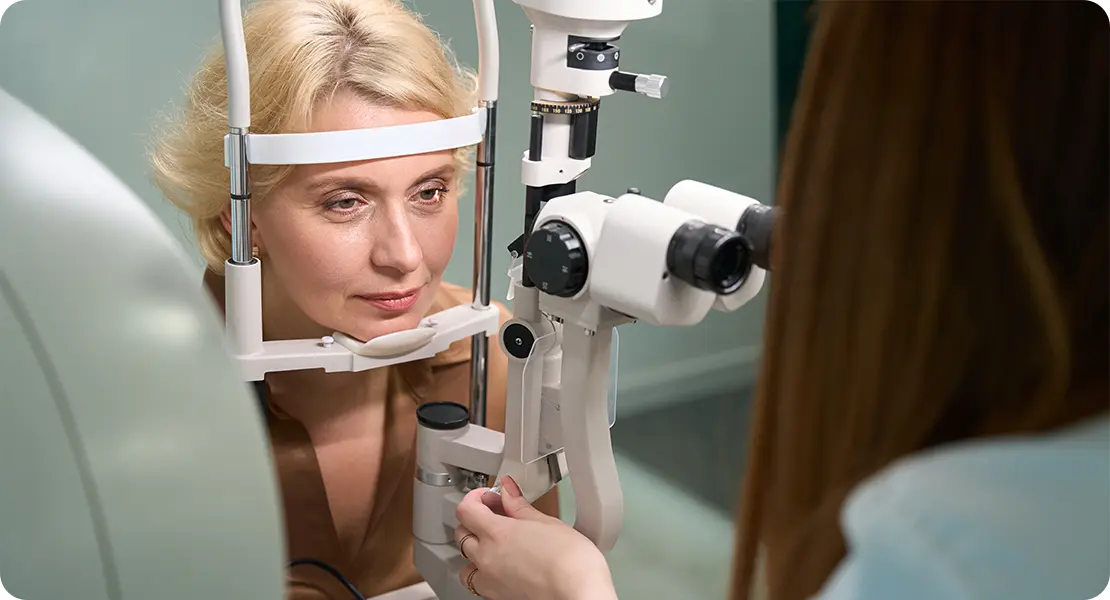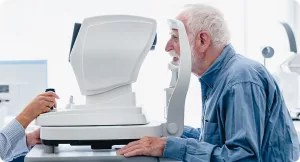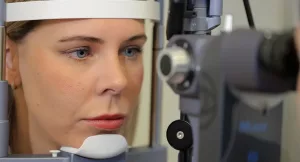What to Avoid if You Have Keratoconus? Practical Tips

If you’ve been diagnosed with keratoconus, it can feel overwhelming at first. You might notice that your vision changes unpredictably, your lenses no longer feel comfortable, or your eyes are more sensitive than before. While modern treatments can manage keratoconus effectively, what you do (and avoid) every day makes a big difference in how stable your condition stays.
The good news is that with the right habits and awareness, you can protect your eyes and reduce the risk of progression. In this guide, I’ll walk you through the key things to avoid if you have keratoconus, practical eye care tips, and small daily habits that make a lasting impact.
It’s also important to remember that you’re not alone in this journey. Many people with keratoconus lead normal, active lives you just need to be a little more mindful of how you treat your eyes and make choices that keep them comfortable and healthy every day.
Understanding Keratoconus in Simple Terms

Keratoconus is a condition where your cornea the clear front part of your eye gradually becomes thinner and bulges into a cone-like shape. This irregular shape causes light to scatter instead of focusing properly, leading to blurred or distorted vision.
It often develops in adolescence or early adulthood and can progress slowly over several years. While it’s not preventable, the rate of progression can often be slowed down with the right care and timely treatment.
Modern keratoconus treatment in London includes options like corneal cross-linking, specialised contact lenses, and advanced surgical procedures that help strengthen the cornea and improve vision.
But beyond clinical care, your everyday habits matter a lot. How you manage your eye health on a daily basis can make a noticeable difference. The small things you do like avoiding eye rubbing, protecting your eyes from irritants, and keeping up with regular check-ups can go a long way in keeping your vision stable and clear.
Why Lifestyle Matters in Keratoconus
Your cornea is already fragile when you have keratoconus. Everyday factors like rubbing your eyes, using contact lenses incorrectly, or exposing your eyes to dryness can worsen the thinning and distortion.
That’s why managing keratoconus isn’t only about treatment it’s also about protecting your eyes from unnecessary strain, inflammation, or trauma.
Think of it this way: treatment strengthens your cornea, while your daily choices maintain that strength. The more mindful you are of how you care for your eyes, the better your chances of keeping your condition stable. Simple habits like giving your eyes enough rest, staying hydrated, and following your optometrist’s guidance can make a real difference over time.
What to Avoid if You Have Keratoconus
Here are the key habits and environmental factors to avoid to keep your eyes healthy and stable.
1. Avoid Eye Rubbing The Biggest Trigger
If there’s one golden rule to follow, it’s this: never rub your eyes.
Eye rubbing is one of the biggest triggers for keratoconus progression. It puts physical pressure on your cornea, which can cause it to thin or change shape even more over time. Even light rubbing, if done often, can make things worse.
If your eyes feel itchy or irritated, try to:
- Use lubricating or anti-allergy drops prescribed by your doctor.
- Apply a cool compress to calm the irritation.
- Identify and avoid your allergy triggers.
Breaking the habit takes practice and awareness, but it’s honestly the best thing you can do to protect your corneas long term.
2. Avoid Wearing Old or Poorly Fitting Contact Lenses
Regular contact lenses aren’t designed for keratoconus and can cause discomfort or even damage. Your cornea’s irregular shape needs custom-fit lenses such as:
- Rigid gas permeable (RGP) lenses
- Hybrid lenses
- Scleral lenses
Wearing the wrong or old lenses can lead to micro-abrasions, irritation, or further corneal thinning. Always get your lenses fitted by an optometrist who has experience with keratoconus and never use damaged or expired lenses.
3. Avoid Sleeping in Contact Lenses
Even if your lenses say they’re “extended wear,” it’s still best to take them out before bed. When you sleep, your eyes get less oxygen, and lenses only add to that restriction making your cornea more fragile.
If you accidentally fall asleep in them, remove them as soon as you wake up, clean them thoroughly, and let your eyes rest before wearing them again.
4. Avoid Eye Dryness
Dry eyes are quite common if you have keratoconus, especially when you wear contact lenses for long hours. Dryness can make your cornea more prone to irritation and microdamage.
To help keep your eyes hydrated:
- Use preservative-free lubricating drops throughout the day.
- Drink plenty of water.
- Avoid sitting directly under fans or air conditioning.
- Take frequent screen breaks.
A little moisture goes a long way in keeping your corneas healthy and comfortable.
5. Avoid Ignoring Allergies
If you struggle with hay fever or allergic conjunctivitis, you’ll know how tempting it is to rub your eyes. Unfortunately, that’s exactly what can worsen keratoconus.
To stay ahead of allergies:
- Use prescribed antihistamine or anti-inflammatory drops.
- Keep windows closed during pollen season.
- Steer clear of dusty or smoky environments.
Managing allergies doesn’t just make your eyes feel better it also helps prevent damage to your corneas.
6. Avoid Using Unprescribed Eye Drops
Over-the-counter drops might seem harmless, but some can actually do more harm than good. Redness-relief drops, for example, can irritate your eyes with overuse. Even steroid drops can thin your cornea or increase eye pressure if not used correctly.
Always check with your ophthalmologist before using any new eye product, and stick to doctor-recommended lubricants or allergy drops.
7. Avoid Excessive Screen Time Without Breaks
We all spend hours staring at screens, but that constant focus can dry out your eyes and make them feel tired or irritated.
To reduce the strain:
- Follow the 20-20-20 rule (every 20 minutes, look 20 feet away for 20 seconds).
- Blink more often to keep your eyes moist.
- Adjust your screen brightness and distance to reduce glare.
Your eyes need regular breaks especially when they’re already sensitive.
8. Avoid Skipping Eye Check-Ups
Keratoconus can change gradually, and regular check-ups are key to spotting those changes early. Your specialist can then adjust your treatment or lens prescription before it affects your vision.
Make sure to visit your eye doctor every 6–12 months, or as often as recommended. Missing appointments might mean missing important early signs of progression.
9. Avoid UV Exposure Without Protection
UV rays can contribute to oxidative stress, which isn’t good news for your corneas. Always wear sunglasses with UV400 protection even when it’s cloudy. Polarised lenses are a great choice if you want extra comfort outdoors.
A simple pair of sunglasses can make a big difference in protecting your vision long term.
10. Avoid Ignoring Discomfort or Vision Changes
If your lenses suddenly feel uncomfortable, your eyes sting, or your vision looks blurrier than usual don’t brush it off. These might be signs of a lens issue, infection, or progression of keratoconus.
Book an appointment with your eye care specialist as soon as possible. Acting early helps prevent small problems from turning into bigger ones.
Practical Tips for Managing Keratoconus

Knowing what to avoid is only half the battle here are practical steps you can take to support your eye health and comfort daily.
1. Stay Consistent with Your Treatment Plan
Whether you’ve had corneal cross-linking, wear scleral lenses, or follow another treatment, consistency is key. Your eyes need regular care to stay stable, so skipping lens wear, delaying follow-ups, or ignoring discomfort can slow your progress or even undo some of your treatment benefits.
Try to think of your eye care routine as part of your daily hygiene just like brushing your teeth. Following your doctor’s advice and sticking to the schedule helps your eyes adjust, heal, and stay as healthy as possible.
If something feels off like sudden discomfort or vision changes don’t wait it out. Get in touch with your specialist early. Small adjustments often make a big difference.
2. Prioritise Hygiene and Cleanliness
Clean hands mean healthy eyes. Always wash your hands thoroughly before touching your lenses or eyes, and clean your lenses exactly as instructed. Replace your lens case every few months (or sooner if it looks dirty or cracked).
Even minor lapses in hygiene can lead to infections or irritation, which can worsen keratoconus symptoms. It may seem simple, but maintaining clean habits is one of the easiest and most powerful ways to keep your eyes safe.
If you ever feel unsure about cleaning solutions or techniques, ask your optometrist to show you the best method during your next visit.
3. Maintain Good Sleep and Nutrition
Your eyes need rest and nourishment to recover and function well. Poor sleep can increase eye strain, making your corneas feel drier or more sensitive. Try to get enough quality sleep every night to give your eyes time to repair and refresh.
A balanced diet also supports eye health. Include foods rich in:
- Omega-3 fatty acids (found in salmon, walnuts, flaxseeds) to reduce dryness and inflammation.
- Vitamin C and antioxidants (from citrus fruits, berries, and leafy greens) to support tissue repair.
- Zinc and vitamin E for maintaining corneal strength.
And don’t forget hydration drinking enough water keeps your eyes lubricated and comfortable throughout the day.
4. Manage Stress and Eye Fatigue
Stress doesn’t just affect your mind it also impacts how your body, including your eyes, responds to strain. When you’re tense, you may blink less, stare at screens longer, or even rub your eyes without realising it.
Take regular breaks, especially during long hours of computer work. Close your eyes for a few minutes, apply a warm compress to relax the muscles, or practise gentle breathing exercises. These small pauses help reduce eye fatigue and improve circulation.
Managing stress helps you stay more mindful of your habits and that awareness protects your corneas over time.
5. Educate Family and Friends
Keratoconus can sometimes run in families, so it’s a good idea to let your relatives know what to watch out for things like frequent prescription changes, blurry or ghosted vision, or sensitivity to light.
Encourage them to schedule regular eye check-ups, especially if they’re in their teens or early adulthood. Early detection allows for timely intervention, which can significantly slow down progression.
Sharing your experience not only helps them but also creates a support system for you. When your friends and family understand what you’re going through, they can remind you to rest your eyes, avoid rubbing, or help you manage daily care more easily.
When to See Your Eye Doctor
If you notice any of the following, it’s important to book an appointment with your eye specialist as soon as possible:
- Rapid changes in your vision, such as sudden blurriness or distortion.
- Increased sensitivity to light that wasn’t there before.
- Frequent headaches, eye strain, or fatigue that interfere with daily activities.
- Unexplained redness, pain, or irritation in your eyes.
- Contact lens discomfort that doesn’t improve despite proper cleaning and care.
Even if symptoms seem minor, early evaluation is key. Your doctor can identify subtle changes, adjust your treatment plan, or refit your lenses before small issues become bigger problems.
Remember, keratoconus can progress gradually, so waiting too long may allow your cornea to change more than necessary. Think of regular check-ups as a form of prevention they give you peace of mind and help protect your vision in the long term.
If you’re ever unsure whether a symptom is serious, it’s always better to err on the side of caution and get checked. Prompt attention can make a huge difference in maintaining comfort, clarity, and eye health.
Treatments That Help Stabilise Keratoconus
Thanks to modern ophthalmology, keratoconus is now highly manageable. Depending on the severity, your doctor may recommend:
- Custom Contact Lenses: Specially designed lenses that fit the irregular cornea and provide clearer vision.
- Corneal Cross-Linking (CXL): A minimally invasive procedure that strengthens the corneal fibres to prevent progression.
- Intracorneal Ring Segments (ICRS): Small implants that reshape the cornea to improve focus.
- Corneal Transplant (in advanced cases): Replacing the damaged cornea with a healthy donor one.
These treatments, available as part of keratoconus treatment in London, aim to restore stability and improve quality of life but they work best when paired with good daily care.
Everyday Do’s and Don’ts for Keratoconus
When you’re living with keratoconus, a few everyday habits can make a big difference in protecting your eyes and slowing down progression.
You should use lubricating eye drops regularly to keep your eyes comfortable and hydrated. Whenever you step outside, wear UV-protected sunglasses they help shield your eyes from sunlight and irritation. It’s also important to follow up regularly with your eye specialist so any small changes in your vision are spotted early.
If you wear contact lenses, always maintain good hygiene when handling them to avoid infection. And don’t forget to eat nutrient-rich foods, as good nutrition supports overall eye health.
On the other hand, try to avoid rubbing or pressing your eyes, as this can make keratoconus worse. Never sleep with your contact lenses in, and don’t ignore sudden vision changes get them checked right away. Avoid using unprescribed eye drops, and keep your eyes away from dust or smoke, which can trigger irritation.
These simple do’s and don’ts can go a long way in keeping your eyes healthy and your vision clear.
FAQs:
- What is keratoconus and how does it affect my vision?
Keratoconus is a condition where the clear, dome-shaped front part of your eye the cornea gradually thins and bulges into a cone-like shape. This irregular shape changes how light enters your eye, causing your vision to become blurry or distorted. You may notice that straight lines look wavy, objects appear stretched, or your eyes feel more sensitive to light. The condition often starts during adolescence or early adulthood and can progress slowly over several years. While it cannot be fully prevented, understanding how it affects your vision and taking steps to manage it can help you maintain clearer sight for longer. - Why does rubbing my eyes worsen keratoconus?
Rubbing your eyes puts physical pressure on the cornea, which is already fragile in keratoconus. This repeated pressure can make the cornea thinner or change its shape, accelerating the progression of the condition. Even occasional or gentle rubbing can cause harm over time, so it’s important to find alternative ways to relieve itchiness or discomfort, such as using prescribed lubricating drops or applying a cool compress. - Can wearing contact lenses help or hurt my keratoconus?
Your cornea’s irregular shape means that standard contact lenses often do not fit properly and can cause discomfort or even micro-damage. Specially designed lenses such as rigid gas permeable (RGP) lenses, hybrid lenses, or scleral lenses provide better vision and protect your cornea. Wearing old, damaged, or poorly fitted lenses can irritate your eyes and worsen the condition, so it’s crucial to have your lenses custom-fitted by a specialist familiar with keratoconus. - Is it safe to sleep in my contact lenses?
Sleeping in contact lenses is not recommended, even if they are labelled for extended wear. During sleep, your eyes receive less oxygen, and lenses can further limit oxygen supply to your cornea. This can make your cornea more vulnerable to damage, irritation, or infection. If you accidentally fall asleep with your lenses in, it’s best to remove them as soon as possible, clean them thoroughly, and give your eyes some rest before wearing them again. - How do allergies affect keratoconus?
Allergies can make your eyes itchy, watery, or irritated, which often leads to rubbing a behaviour that can worsen keratoconus. Managing allergies with prescribed antihistamine or anti-inflammatory drops, keeping your environment free from dust and pollen, and avoiding triggers can help protect your cornea. Taking steps to control allergic reactions also improves your comfort and reduces the risk of vision changes over time. - How often should I see my eye doctor?
Regular check-ups are essential because keratoconus can progress gradually without noticeable symptoms. Seeing your specialist every six to twelve months, or as recommended, allows them to monitor changes in your cornea, adjust your lens prescription, and recommend treatments if needed. By keeping up with appointments, you can catch early signs of progression and take proactive measures to preserve your vision. - Can lifestyle choices make a difference in managing keratoconus?
Yes, your daily habits play a significant role in maintaining corneal stability. Avoiding eye rubbing, managing dryness, taking breaks from screens, wearing UV-protected sunglasses, staying hydrated, and following your treatment plan all contribute to healthier eyes. Even small actions, like getting enough sleep, eating a nutrient-rich diet, and reducing eye strain, can have a long-term impact on the comfort and clarity of your vision. - What treatments are available for keratoconus?
Depending on the severity of your condition, treatments can range from custom contact lenses that fit your cornea to procedures like corneal cross-linking, which strengthens the cornea’s structure. In some cases, intracorneal ring segments can reshape the cornea, and advanced cases may require a corneal transplant. These treatments aim to stabilise your vision and reduce progression, but they work best when paired with careful daily eye care. - How can I protect my eyes from UV damage?
UV rays contribute to oxidative stress, which can harm your cornea. Wearing sunglasses with UV400 protection whenever you are outdoors, even on cloudy days, shields your eyes from harmful rays. Polarised lenses can offer additional comfort by reducing glare. Simple habits like this help prevent long-term damage and support your overall eye health while living with keratoconus. - What should I do if I notice sudden vision changes or discomfort?
If you experience blurred vision, unusual stinging, irritation, or discomfort with your lenses, it’s important not to ignore these signs. Such changes could indicate lens issues, infection, or progression of keratoconus. Booking an appointment with your eye care specialist as soon as possible allows them to assess the situation, adjust your treatment, and prevent small problems from becoming more serious. Prompt attention is one of the most effective ways to protect your long-term vision and eye comfort.
Final Thoughts: Protecting Your Eyes with Smart Habits
Living with keratoconus doesn’t have to limit your life but it does mean being mindful of how you care for your eyes. Avoiding harmful habits like rubbing, neglecting dryness, or skipping check-ups can dramatically slow the condition’s progression. The goal isn’t just to manage keratoconus, but to protect your long-term vision and comfort.
If you’d like to explore the options that might work best for you, you can contact us at Eye Clinic London to discuss keratoconus treatment in London. We can examine your eyes, walk you through the available treatments, and guide you in choosing the options that fit best with your vision needs and lifestyle. Being proactive now can have a lasting impact on the health of your eyes in the future.
References:
- Najmi, H., 2019. The correlation between keratoconus and eye rubbing. National Center for Biotechnology Information. Available at: https://pmc.ncbi.nlm.nih.gov/articles/PMC6848869/
- Mazharian, A., 2023. Medium to long term follow up study of the efficacy of stopping eye rubbing in keratoconus patients. National Center for Biotechnology Information. Available at: https://pmc.ncbi.nlm.nih.gov/articles/PMC10244573/
- American Optometric Association, 2023. Keratoconus. American Optometric Association. Available at: https://www.aoa.org/healthy-eyes/eye-and-vision-conditions/keratoconus
- Verywell Health, 2025. 8 Everyday habits that can hurt your eyes in the long run. Verywell Health. Available at: https://www.verywellhealth.com/8-everyday-habits-that-damage-eyes-11820447
- Vision Institute, 2025. Preventing keratoconus progression | Lifestyle tips. Vision Institute. Available at: https://www.vision-institute.com/preventing-keratoconus-progression-lifestyle-changes-and-habits-to-consider/

